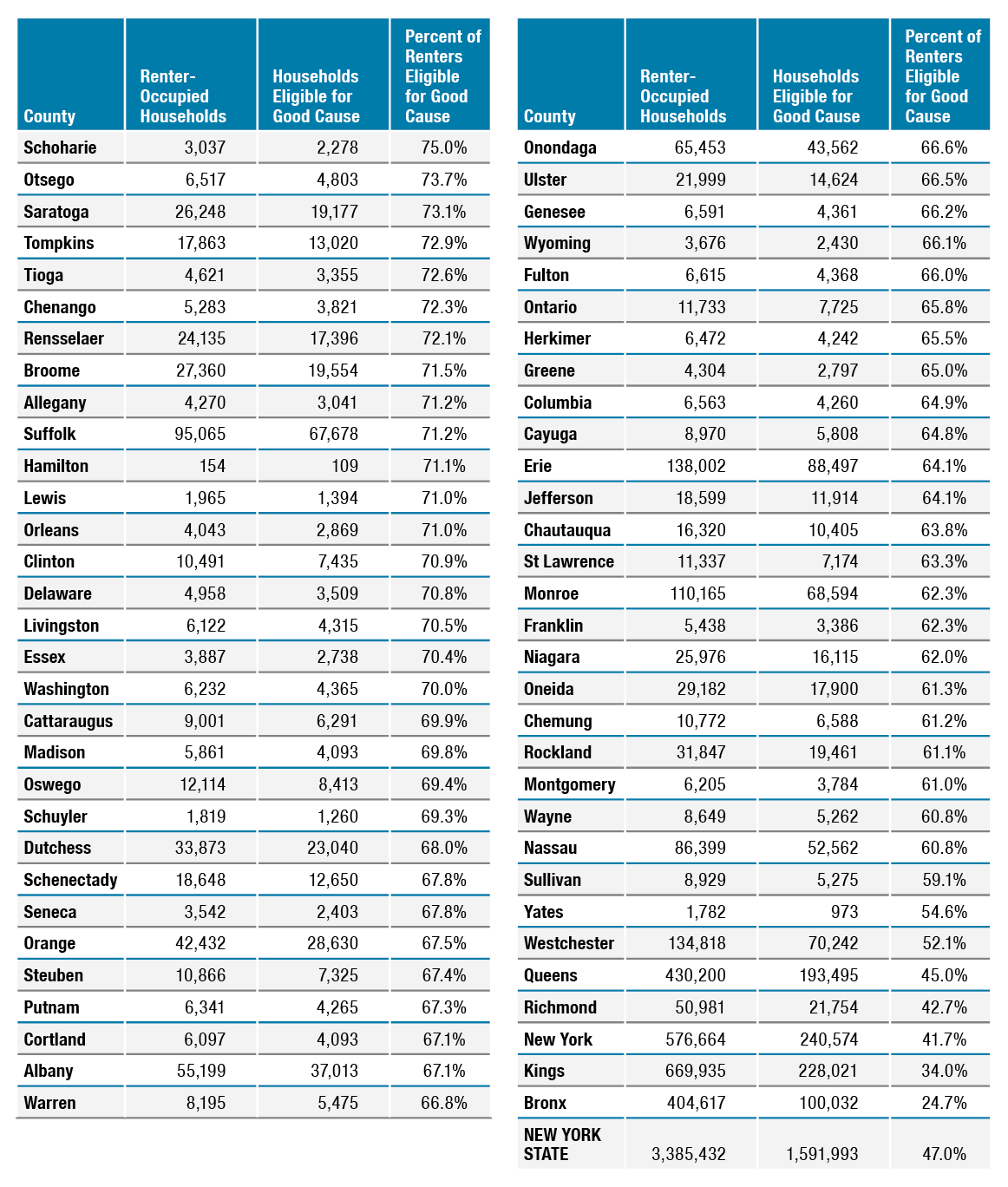Good Cause Legislation Would Protect 1.6 Million Households, Nearly 50% of Tenants Statewide
Kate Ham
The COVID-19 pandemic has hurt renters across New York State. Per the most recent data from the Household Pulse Survey (August 30, 2021), 53 percent of New York renter households making less than $100,000 were not highly confident they could pay next month’s rent, and 39 percent of New York renter households are at risk of eviction in the next two months. Rents have been rising rapidly in 2021 with an average increase of 9.4 percent nationwide since the start of the pandemic.
Even before COVID-19, we had an eviction epidemic; about 100 families were evicted every day in New York State. With an eviction crisis looming following the Supreme Court’s recent injurious ruling and the full expiration of the statewide eviction moratorium looming on January 15, it is clear that New York renters are in trouble.
Tenant advocates are turning towards a promising new policy: good cause eviction protections. Good cause eviction protections would provide tenants with a baseline “right to remain” by prohibiting no-fault evictions and requiring landlords to justify rent increases greater than 3 percent with a “good cause.” A “good cause” is generally defined as substantial violations of a lease, such as failure to pay rent or serious destruction of property. If a tenant receives an eviction notice without a legal reason, the tenant can challenge the eviction in court under good cause protections.
Good cause has widespread benefits. Foremost, it gives tenants stability, security, and legal protection against arbitrary rent hikes or displacement. Too often tenants prematurely move out (or “self-evict”) when they fear displacement. Good cause can also embolden tenants to stand up for their rights. Under good cause, when tenants experience poor living conditions, discrimination, or other illegal landlord behavior, they can safely take up the issue with their landlord or file a complaint without fear of retaliatory eviction.
Moreover, good cause eviction stabilizes communities. The policy curbs speculation by making it more difficult for large investors to flip rental housing and hike up the rents. Evidence from four California cities with a similar policy found lower eviction rates and lower eviction filing rates. With less displacement and more emplacement, we can grow healthier communities.
Efforts to pass good cause in New York are ongoing. In 2019, a bill was introduced in the New York State Senate (S2829B sponsored by Senator Julia Salazar) and Assembly (A05030B sponsored by Assemblymember Pamela J. Hunter), and again in both houses 2021 (S3082 and A5573), but the bills were never put to a vote. Now, efforts are turning towards the local level. With the success of good cause eviction in the city of Albany in July, municipalities around the state are hopeful that this strategy can scale upward. In recent weeks, a bill passed in Hudson, another is currently being debated in New Paltz, more have recently been introduced in Newburgh, Ulster County, Kingston, and Poughkeepsie, and one is being demanded by the Ithaca Tenants Union. (Unfortunately, the state’s Urstadt Law prevents New York City from establishing good cause eviction protections without state authorization, but no other municipality is subject to that rule.)
New Data on Good Cause Eviction
The Community Service Society supports calls for good cause eviction across New York state, and we offer some new calculations to show just how impactful the policy would be—for tenants, for localities, and for the state as a whole.
According to the 2021 version of the bill, good cause eviction would apply to all rental units except those in small, owner-occupied buildings, or those which already have comparable protections (i.e., public, subsidized, and rent-stabilized apartments). Using the most recent American Community Survey and a variety of other publicly available datasets, we have compiled the estimated number of households who would benefit from good cause protection in every county in New York (see table below).
Here are some key findings based on the statewide bill:
-
About 1.6 million renter households in New York State—nearly half the state’s renters—would be newly covered by good cause eviction protections.
-
For all counties outside New York City, over 50 percent of renters would be eligible for good cause protections. For half of New York’s counties, at least 2 of every 3 households are eligible.
-
The relatively lower rates of eligibility in New York City are due to the city’s high percentage of public, subsidized, and stabilized rentals, which already carry comparable or stronger protections. In other words, more New York City tenants already have comparable eviction protections than renters elsewhere in New York State.
Explore the interactive map below to see how tenants in each county in New York State would benefit from good cause legislation:
Methodology:
To calculate good cause protections eligibility for each county, we used ACS 2019 (5-year) data to count the total number of renter households by county. Next, we subtract public, subsidized, and rent stabilized housing units with pre-existing good cause protections using a combination of data from New York State Homes and Community Renewal and the Furman Center, being careful to remove any duplicated data. Finally, we subtracted the households in small, owner-occupied buildings. While this data is difficult to find for most of New York State, the 2017 NYC Housing Vacancy Survey provides detailed findings on owner occupancy in small rental buildings in New York City. New York City is quite different from the rest of the state in terms of housing type and tenure, but Staten Island provides a reasonable proxy on which to make an estimate. We find that 35% of rentals in Staten Island are small and owner-occupied, and thus exempt from the bill, and we apply this percentage elsewhere.
For more detailed information and code scripts, please reach out to CSS at sstein@cssny.org.
